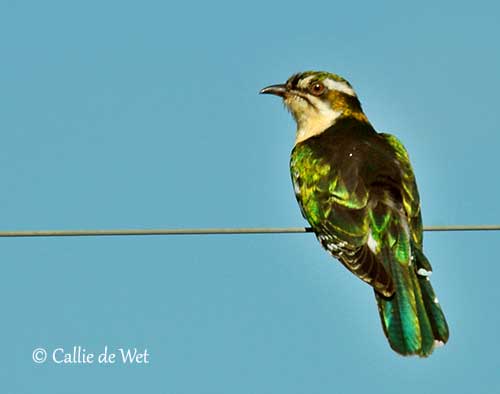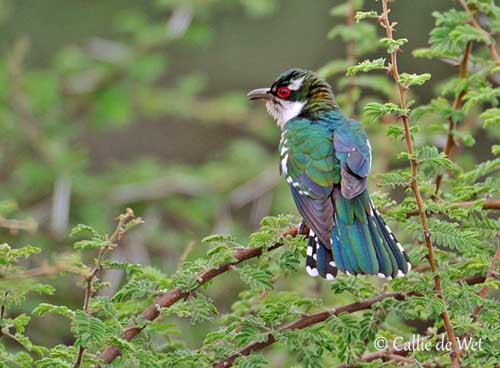
Fr: Coucou didric
Ang: Diederik Cuckoo
All: Goldkuckuck
Esp: Cuclillo Didric
Ita: Cuculo dorato di Levaillant
Nd: Diederikkoekoek
Sd: didrikglansgök
Photographers:
Aurélien Audevard
OUESSANT DIGISCOPING
Jean Michel Fenerole
Photos d’Oiseaux
Callie de Wet
GALLERY
Jean Marc Rabby
Des Ailes et des Plumes
Text by Nicole Bouglouan
Sources:
HANDBOOK OF THE BIRDS OF THE WORLD vol 4 by Josep del Hoyo-Andrew Elliott-Jordi Sargatal - Lynx Edicions - ISBN: 8487334229
BIRDS OF THE GAMBIA AND SENEGAL by Clive Barlow and Tim Wacher – Helm Field guides – ISBN: 0713675497
BIRDS OF AFRICA SOUTH OF THE SAHARA by Ian Sinclair and Peter Ryan - Princeton University Press Princeton and Oxford - ISBN: 0691118159
BIRDS OF EAST AFRICA vol 1 by C.A.W. Guggisberg – Mount Kenya Sundries Ltd. – ISBN: 9966889051
Wikipedia, the free encyclopaedia
Diederik cuckoo, Chrysococcyx caprius – interesting birdwatching
Wilkinson’s World - Bird of the week – Week 55: Diderick cuckoo
Africa Geographic - Cuckolded – a weaver raises a cuckoo chick

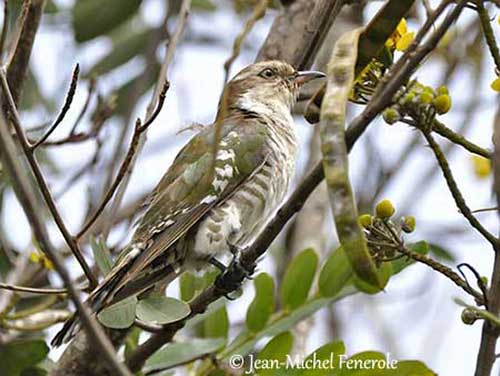
Diederik Cuckoo
Chrysococcyx caprius
Cuculiformes Order – Cuculidae family
INTRODUCTION:
The Diederik Cuckoo is a member of the subfamily Cuculinae within the large family Cuculidae. This subfamily includes the Old World parasitic cuckoos. The name “diederik” is an approximate rendition of the loud, persistent “deed-deed-deed-er-ick” call of the territorial male.
It frequents woodlands, savannas, grasslands and suburban gardens, and may occur near water. It is often seen close to weaver’s colonies. It is found in sub-Saharan Africa and in a smaller range in South Arabia.
The Diederik Cuckoo is usually common throughout the wide range, and the species is not currently threatened.
DESCRIPTION OF THE BIRD:
Biometrics:
Length: 19 cm
Weight: 30-32 g
The Diederik Cuckoo adult male has green upperparts with a coppery sheen on the back. We can see several rows of white spots on the wing-coverts, also visible on closed wings. On the tail, the outer rectrices are green with fairly small white spots.
The underparts are white, including chin and throat. Breast sides and flanks are variably barred copper-brown.
On the green head, we can see some white marks on the crown. The white supercilium is conspicuous, but it is sometimes broken above the eye. It extends from lores to ear-coverts. A narrow, green malar stripe contrasts with the white cheeks.
The bill is black. The eyes are red, surrounded by red eyering. Legs and feet are grey.
The adult female (not displayed) is duller than male, with more pronounced coppery sheen on the back. Chin and throat are washed brownish and the breast is often slightly streaked. The wings and tail’s spots are buff (not white).
On the head, the crown is more uniform than in male. She has mostly brown to grey eyes, surrounded by brown eyering.
The juvenile resembles female. It has dull green to bright rufous upperparts. On the buffy-brown underparts, the breast is spotted (not streaked) and the flanks are barred. The bill may appear coral-red in good light. The eyes are brown. The eyebrow is less visible than in adults.
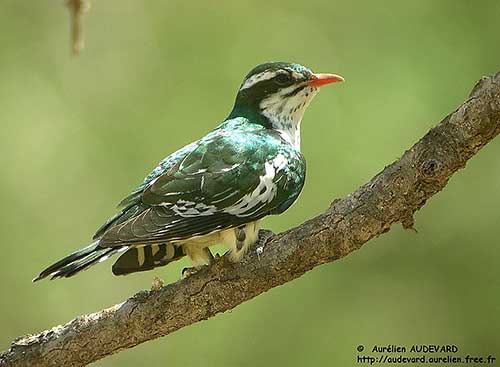
RANGE:
The Diederik Cuckoo is common resident in sub-Saharan Africa and S Arabia. The species is an intra-African migrant, with movements related to the rains.
HABITAT:
The Diederik Cuckoo frequents semi-arid areas, open woodlands, savannas, often at edges of marshy habitats, and sometimes in suburban gardens. It can be found near water, often reedbeds, in semi-arid regions, and often occurs near weaver’s colonies where the female lays her eggs. She is usually chased by the nesting birds.
The species is usually found below 1200 metres, but it may occur from sea-level up to 2000 metres of elevation.
CALLS AND SONGS: SOUNDS BY XENO-CANTO
The Diederik Cuckoo utters a loud, plaintive “dee-dee-dee-dee-er-ick” giving the bird its name. This song is repeated over and over again with variable number of “dee”. The first two syllables are slower than the following notes. This song is given by the territorial male while declaring its territory from treetops. The female may answer with a “deea-deea-deea”. Like most Cuculidae, the Diederik Cuckoo is more often heard than seen!
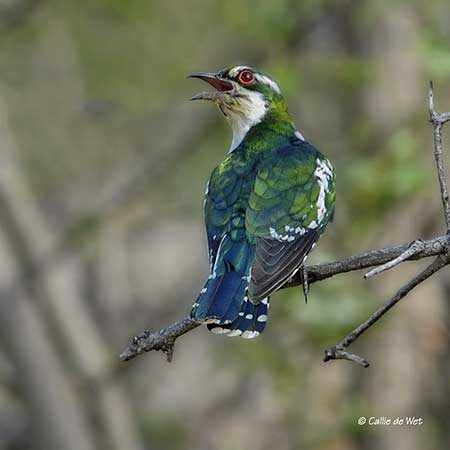
BEHAVIOUR IN THE WILD:
The Diederik Cuckoo feeds mainly on hairy caterpillars and insects such as termites, grasshoppers, beetles and Lepidoptera adults. It also eats the eggs of the host species and consumes seeds too.
It forages usually among the foliage of trees and bushes, and gets the prey from stems or leaves. It may sometimes fly down to the ground to take some food item.
The hairy caterpillars eaten by the Diederik Cuckoo are poisonous to most other bird species.
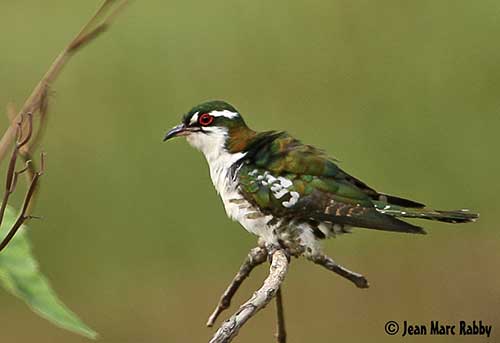
Male and female perform distinct feeding behaviour that is part of courtship. To attract a female, the male sings and then, it catches a caterpillar for her. Both adults engage in displays, a dance during which they bob their partially spread wings up and down. The male passes the caterpillar to the female and during several seconds, if she accepts the gift, both birds hold one end of the prey. This behaviour usually occurs prior to copulation.
The Diederik Cuckoo is a brood parasite. The host birds often mob the cuckoo on groups.
The Diederik Cuckoo is usually a solitary bird and it is often seen singly within its habitat. It is an intra-African migrant, reaching southern Africa from central and east Africa in September/October. The return migration takes place in March/April. The species is summer visitor in Oman.
The Diederik Cuckoo flies and glides about with the tail spread while calling loudly.
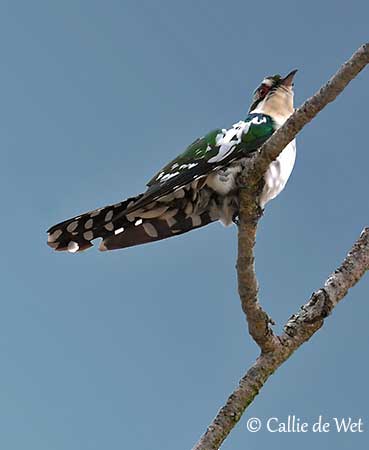
REPRODUCTION OF THIS SPECIES:
The Diederik Cuckoo breeds during the wet season. The laying varies depending on the range (late October/mid-January in South Africa, August/October in N Senegal, October/April in Malawi, April/May and November/January in Kenya).
It is a brood parasite, and the usual hosts are mainly weavers (Ploceus), bishops (Euplectes) and sparrows (Passer). The female lays her egg in the host nest, but first, she destroys any eggs or chicks before laying her own egg. When she leaves the nest-site, she is usually mobbed and chased by the hosts. The cuckoo’s eggs are white or blue with variable brown spotting, and the host usually does not notice the exchange.
The incubation lasts about 12 days. At three days old, the cuckoo chick eats both eggs and chicks that were not in the nest when the female cuckoo laid her egg. It remains at nest during 19-22 days. Then, it leaves the nest, but it still depends of the foster parents during three weeks more.
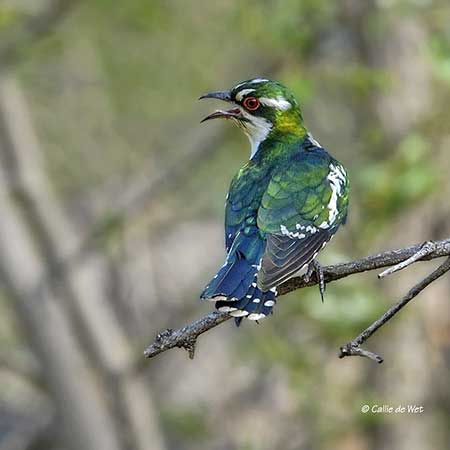
PROTECTION / THREATS / STATUS:
The Diederik Cuckoo is usually common throughout most of the wide range, even in heavily humanized habitats.
The population size in unknown but it is suspected to be stable. The species is not globally threatened.
The Diederik Cuckoo is currently evaluated as Least Concern.
